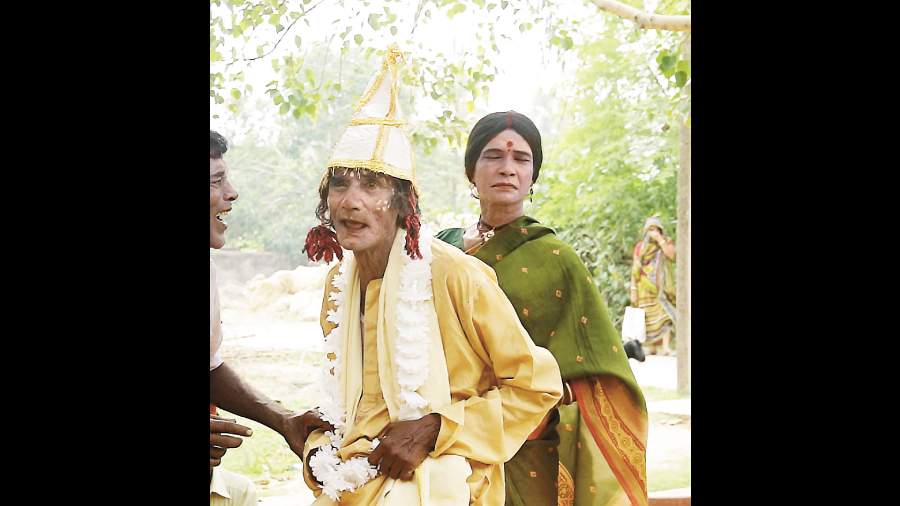Anik Dutta’s Aparajito, which is meant to be a tribute to Satyajit Ray’s making of the 1955 classic Pather Panchali, was released earlier this year. Though the film evoked a mixed response, it rekindled fond memories of Chunibala Devi, the 80-year-old forgotten stage actor who played Indir thakrun in Ray’s film. For his film, Dutta picked Hara Kumar Gupta, a little known “male” folk artiste, to play Chunibala. Gupta’s performance barely lasted five minutes, but it was memorable.
Leto gaan or leto is a performance popular in the Birbhum, Burdwan, Bankura and Murshidabad districts of West Bengal. It is much like the jatra with its combination of elements — song, dance, drama and loud music. And until recently, in leto, male actors played women characters.
Speaking to The Telegraph over phone from Kharia, a village near Mohammad Bazar in Birbhum district, Gupta describes in detail how thespian Debesh Chattopadhyay saw him perform at Calcutta’s Tapan Theatre and referred him to Dutta.
The 73-year-old recalls how he took up leto when he was in his 30s; he had been inspired by his mentor Kumar Bagdi. Gupta says, “This folk theatre form has always been looked down upon by the bhadrolok, but for rural folks it has been a popular form of entertainment for centuries.”
Gupta’s troupe, named Sri Durga Leto Asor, employs 10-12 actors and actresses who travel across the hinterland to perform, especially from autumn to spring. A long version of a pala (play) can run from 8pm till early morning; shorter skits last three or four hours and are performed at village fairs after sundown.
In his slim book Leto, Barun Kumar Chakraborty, folklore expert and professor emeritus of Rabindra Bharati University, tells the story of the origin and development of this performance art. He writes, “The tapestry of traditionally composed songs and improvised dance is accompanied by musicians who play instruments such as the bamboo clarinet, harmonium, tabla, cymbals, flute and dubki.”
Leto is usually performed in the corner of a fairground or field after the autumn harvest; there’s not even a raised platform or macha unlike that used in a jalsa or jatra.
Says Gupta, “Usually we don’t have any set script, just an outline of the pala. There’s a lot of scope to improvise, based on audience reaction and reception.”
Traditional letos derived their plot outlines from both Hindu and Islamic myths and legends. These pastoral plays, performed by actors clad in colourful everyday clothes, gradually started raising social and political issues.
“In recent times, we even tried to disseminate the issue of gender discrimination that is obvious in marriage customs. The pala in question is called Lyalar Biye,” says Gupta.
A typical pala has four stages — bandana (invocation), sanlap (conversation), dance and humour. The leto artiste usually invokes Saraswati, the goddess of music and education: Esho ma Saraswati sarvamangala/Tomari naamer guney/Berai amra tribubhone... O Mother Saraswati, the benevolent one/With your blessings/We roam the world.”
Since a large section of performers as well as the audience are Muslims, sometimes you’ll hear songs like this: “Ma Fatemar Fariade/Allajir oi aras kanpe/Karbala oi matlo shune/Kandere jahan... After Mother Fatima’s pleas/The river of Allah quakes/The mourning at Karbala/It makes the whole world weep.”
The poet, musician, composer, novelist and playwright Kazi Nazrul Islam had made his debut as a leto artiste in Churulia, his birthplace near Asansol, when he was nine years old. He had joined his uncle Bajle Karim’s troupe. Says Devajit Bandyopadhyay, a musician and an archivist, who wrote the book Nazruler Natyasangeet, “Exposure to folk theatre early in life helped him pick up skills as a poet, playwright and music composer. Then he began learning Bengali and Sanskrit, and reading their literatures, in addition to his childhood education on Persian and Arabic to polish his skills at leto gaan.”
Folk researcher Swapan Kumar Thakur, however, traces the origin of leto to alkap, another folk musical theatre form popular in Murshidabad and Malda. He says, “Novelist Syed Mustafa Siraj was a performer of alkap. His autobiographical novel Maya Mridanga revolves around it.” According to Thakur, leto has now transformed into something called pancharas, rife with profanities.
Gupta admits that leto has drastically transformed to survive the onslaught of television serials, movies and web series. He says, “But I can assure you, our plays are far more refined than what you get from online media via smartphones.”
He concludes his long interview with his own composition in tribute to Nazrul: “Hey mor Kavi Nazrul/ Bhuli nai tomar naam... Dukhu Mian naamti niye... Leto gaane achhe go pramaan.” The lines are basically a tribute to Nazrul’s proficiency as a leto artiste.
Following his performance in Aparajito, Gupta has been receiving many offers from the Bengali film industry. But he’s refused those. He says, “I am old and infirm; it is difficult for me to travel for hectic shooting schedules on location. I don’t yearn for much. I am happy that people like you are exploring the dying art of leto after seeing the movie and my bit role in it.”











